THE KIND-OF-HANDY OWNER’S GUIDE TO AIR CONDITIONERS: HOW TO CHOOSE AND MAINTAIN YOUR AC
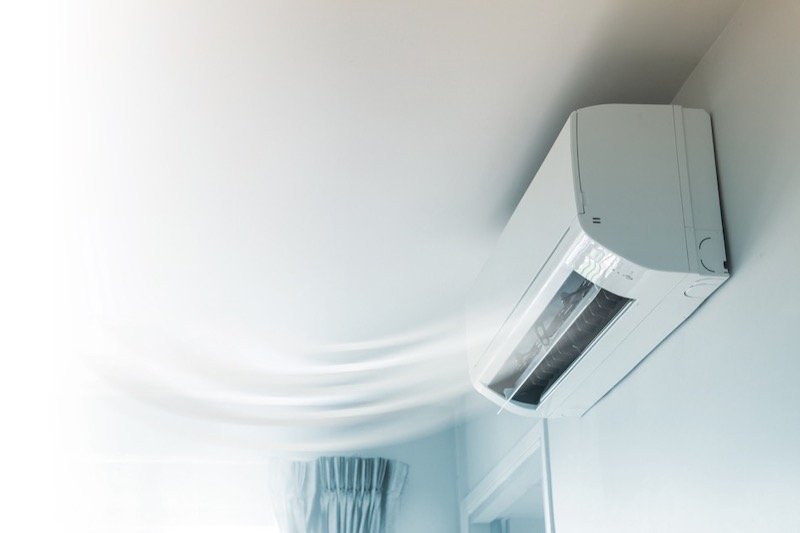 Air conditioning units provide much-needed cooling and relief in our homes during hot summer months. Like any machine, however, air conditioners require cleaning and maintenance, and eventually must be upgraded or replaced. Staying on top of these tasks is important, as is knowing the signs of an old or broken machine.
Air conditioning units provide much-needed cooling and relief in our homes during hot summer months. Like any machine, however, air conditioners require cleaning and maintenance, and eventually must be upgraded or replaced. Staying on top of these tasks is important, as is knowing the signs of an old or broken machine.
If you can recognize the warning signs of a problem and engage in regular maintenance when it’s needed, you can extend your air conditioner’s service life and save money at the same time. This article will discuss the parts of an air conditioner, review best practices when maintaining an air conditioner, and go over the symptoms of an air conditioner problem.
TYPES OF AIR CONDITIONERS
There are four main types of air conditioning units: central, window, ductless (mini split), and evaporative cooler. These main types range in cost and function. They also range in energy usage, as 6% of a home’s energy usage is dedicated to cooling costs, but this can be dramatically reduced by purchasing an energy-efficient machine.
Whether you’re buying an air conditioner for your new construction home or buying a new air conditioner for an existing property, it’s helpful to know the difference between each type of unit.
If your home already has an existing air conditioner, you should understand the way your air conditioner works, and how it compares to other units. Knowing the pros, cons, cost and average life span can help you decide which type of air conditioner makes the most sense for your budget and lifestyle.
CENTRAL AIR CONDITIONERS
Approximate cost to install: $3,000 to $7,000
Central air conditioners rely on air ducts to circulate cool air throughout the home. Openings in the walls leading to ducts, called registers, allow cold air to enter each room. Return ducts and registers keep the air circulating by allowing the air to flow back into the duct system and then into the air conditioning unit. Central air conditioners last about 15 to 20 years. Installation of a central system can be costly if your home doesn’t have ducts already built in.
However, central air conditioning is quiet, convenient and very common. As a result, finding someone to repair a broken central air conditioner system is easy, and replacing an old central air system can be equally easy. Central air dehumidifies as it runs, thus protecting the home from mold and mildew that might otherwise grow inside.
Most residential central air conditioners are split-systems, with a condenser outside in the yard, and an indoor component containing the evaporator. The outdoor component is held in a cabinet, often situated on a concrete slab near the home. The outdoor cabinet contains “fins” or slits, which enable air to flow around and inside the unit. Usually, this indoor component is attached to a furnace.
ROOM (WINDOW) AIR CONDITIONER
Approximate cost to install: $100 to $500
A room air conditioner, also known as a window air conditioner, is a type of air conditioner attached to the home with screws or nails, mounted to the window sill with one portion of the unit (the evaporator side) inside the home and one portion (condenser unit) outside the home. Window air conditioners are only designed to cool one room of the house at any given time.
Modern window air conditioners are usually operated via a remote control or via a digital face panel on the side facing indoors. When operating, the thermostat measures the temperature of the air returning to the unit. When the temperature of the air matches the temperature setting of the thermostat, the unit clicks off.
Like central air conditioning, window air conditioners can help control humidity in the home. Water drips from the window air conditioner while it’s operating.
Window air conditioners are among the most popular types of air conditioners because they’re affordable and can be easily installed in a home that does not have ducts. Window air conditioners are also portable, and can be moved from one room to another or from one home to another, if the owner chooses to bring it with them when moving. However, a poorly installed window air conditioner can leak air around the edges of the unit, resulting in poor energy efficiency.
Window air conditioners typically last about 15 years.
DUCTLESS, MINI-SPLIT
Approximate cost to install: $2,000 to $14,500
Ductless mini-split systems are made up of an indoor air handling unit connected to an outdoor condenser. These two parts are connected via wires and pipes. These systems do not rely on air ducts, and are an excellent option for homes without ducts.
Mini-split systems are very common in certain parts of the world, but are only now catching on in the United States. Ductless systems work much like standard air conditioners, except for one major difference: they can work in reverse. On a hot day, a ductless mini-split system will cool the home. On a cold day, the ductless mini-split can be thrown into reverse to heat the home, and blow cold air into the yard.
Ductless mini-split systems can be particularly expensive to install, especially in a home with an existing duct system but no old mini-split system. However, ductless mini-split units are highly energy efficient because they do not rely on ducts, which can become leaky over time. They cost less money to run and are environmentally friendly. In addition, performing maintenance on the unit is easier than the air conditioner and furnace, which are repaired separately by contractors. Ductless mini-split systems typically last between 12 and 15 years.
EVAPORATIVE COOLER
Approximate cost to install: $1,500 to $3,500
Evaporative coolers are relatively inexpensive and energy efficient, especially when compared to standard air conditioner units. However, these appliances only function in arid environments, because they rely on evaporation to cool the air.
Evaporative coolers are constructed based on the idea the highest-energy particles evaporate from water first, leading to a drop in air temperature. This is why a damp cloth can cool the body, and why water-misted air feels cool even when the air outside is hot. Evaporative coolers require more maintenance than many air conditioners, but can last as long as 20 years if they receive proper care.
HOW DOES AN AIR CONDITIONER WORK?
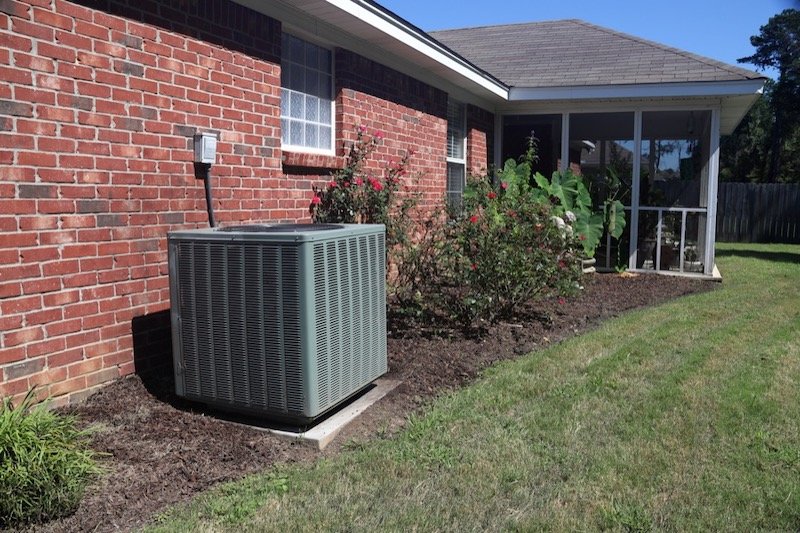
Before you can properly maintain and clean your air conditioner, you should first understand how it functions. Once you know how your air conditioner operates, you may be able to identify when it’s having a problem and what needs to be done to repair it.
Knowing how your air conditioner operates can also help you identify when it’s time to replace your air conditioner. After your air conditioner reaches a certain age, replacing your unit with something more modern can lead to better energy efficiency at home.
BASIC OPERATIONS
Simply put, standard air conditioners (central air conditioners, window air conditioners and ductless mini-split) work by removing heat inside a structure and blowing it outside. The heat inside the structure is absorbed by coolant contained in coils. The heat is transported by the coil to a location outside the structure. A fan in the outside unit blows the heat away from the structure, thus transferring the heat outside.
You can think about the coolant’s journey like this:
- Cooled refrigerant courses into the evaporator coils (inside the home)
- A fan blows the cool dry air into the home’s interior
- Coolant absorbs heat from the home’s interior
- Coolant is compressed to become a high-temperature, pressurized gas, which is then transferred outside
- A fan blows on the coil containing high-temperature gas to blow the heat into the outdoor air
- The coolant is condensed into a cold liquid
- The process starts over again
Most residential air conditioners are split systems, which means some parts of the air conditioner are located outside and some parts are located inside. Air conditioners are made up of five basic parts.
COMPRESSOR
The compressor is the pump that keeps refrigerant flowing through the system, from the evaporator coils to the outside condenser coils and back. Compressors are controlled by the home’s thermostat. When the thermostat reaches the right temperature, the compressor turns off and the unit stops working.
CONDENSER
The condenser coil is a series of pipes containing refrigerant. As the refrigerant passes through the coils, it begins as high-pressure, hot gas, and leaves the condenser coils as cold liquid. A fan blows cool outside air across the condenser coils to cool the refrigerant inside.
EVAPORATOR COIL
The evaporator coils are located inside the house. The air handler blows indoor air across the evaporator coils, and when this happens, the refrigerant inside the coil absorbs heat in the home.
BLOWER
Air handlers, also sometimes just called blowers, use a fan motor to move air-conditioned air through the home. Some air handlers operate at variable speeds, while others work in only one speed. The most efficient blowers can operate at variable speeds.
CHEMICAL REFRIGERANT
Chemical refrigerant is a chemical that can absorb heat and change from a liquid to a gas. Refrigerants are used in air conditioners, heat pumps and refrigerators. Chlorofluorocarbons (CFCs) are a common refrigerant. However, this chemical is being phased out because of the environmental impact.
AIR CONDITIONER FILTERS
Air conditioner filters are generally made of spun fiberglass material, and are designed to trap and hold particulates and contaminants. The types of contaminants trapped by air conditioner filters can vary from one type of filter to another, but in general, filters are designed to trap the following:
- Mold and spores
- Dust and grime
- Microorganisms
- Pollen
- Lint
- Dander
- Hair
Filtration occurs before the air is sucked into the HVAC equipment and blown over the evaporator coils. The filter prevents the coils from becoming dirty.
MERV RATINGS
MERV ratings (1-16) indicate the level of filtration of each air filter. Standard residential air filters are usually numbered in the 6-8 range, while the most high-efficiency filters are rated 16. Although there are MERV ratings higher than 16, these filters typically put too much pressure on air handlers, which must work harder to force air through the filter. Using an air filter rated too high can increase wear and tear on your air conditioner unit, and may cause it to burn out prematurely. People who are concerned about filtering their air as effectively as possible may wish to purchase a separate air purification device, which can remove allergens, mold spores and other air-borne particulates.
WHEN TO CLEAN OR REPLACE
HVAC air filters will become dirty and clogged and must be cleaned or replaced periodically. A clogged air filter can cause the evaporator coils to freeze, which can stop the air conditioner from functioning.
Failure to change the air filter can force the air conditioner to work harder than necessary to do its job, or may result in contaminants coating the evaporator coils, which could also impact the effectiveness of the air conditioner. A dirty air filter can also lead to contaminants accumulating in the ductwork, which in turn can spread dust throughout the house.
The EPA recommends changing the air filter every three months at minimum. You can decide for yourself when it’s time to change the filter by conducting a visual inspection. Hold the filter up to the light. If you cannot see light through the filter, then it’s time to change it.
Filters are easy to change.
- Turn off the HVAC system
- Remove the filter from its slot near the return air duct
- Take the filter to your local hardware store or home improvement center
- Find a replacement filter to match the air filter
- Throw away the old filter
- Insert the new filter into the slot near the return air duct
Some types of filters are washable. These filters require a little more work, but last longer than disposable filters. Read manufacturer’s instructions before trying to wash your filter for the first time. Wash your filter about once per month to ensure the filter will come clean during cleanings.
HOW TO CLEAN AN AIR CONDITIONER
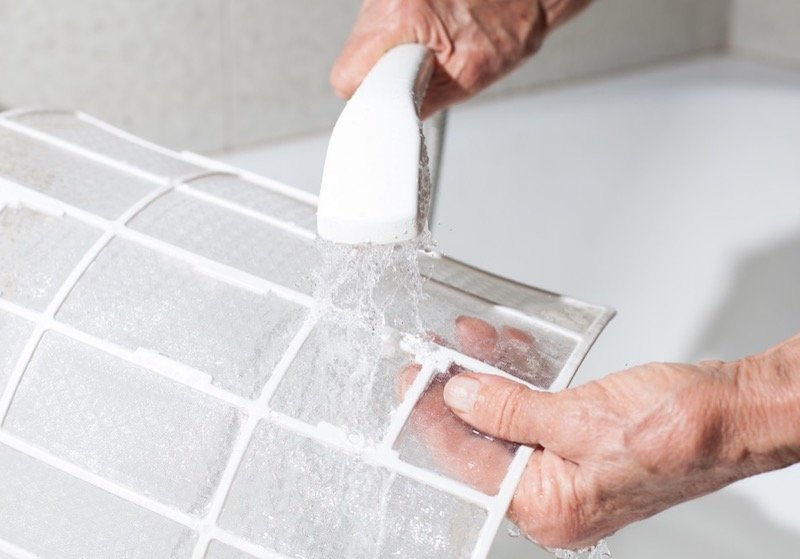
Air conditioners rely on good air flow to ensure they’re functioning properly. When the interior components of an air conditioner become dirty, the air conditioner may stop functioning well. Cleaning the inside of your air conditioner periodically can help ensure your unit will last a long time.
Air conditioner cleaning, which is a multi-step process, can be accomplished by a homeowner with the right tools and a desire to do the work themselves.
CONDENSER COILS
The condenser coils, which are the exterior components of the air conditioner, are encased in a cabinet with fins that enable air to flow in and out. Condenser coils can get dirty, especially when leaves and other pieces of debris make their way inside the cabinet. You can protect this part of your air conditioner by preventing weeds, mulch, dead leaves and other pieces of debris from coming into contact with your unit. However, you should also clean the inside of your air conditioner condenser on a regular basis.
MATERIALS NEEDED
- Coil cleaner
- Screw driver
- Shop vacuum
- Hose
- Fin comb
PROCESS
- Cut the power to the HVAC system at the breaker box
- Clear the area around the condenser; remove mulch, dead leaves and debris in the vicinity that could get inside the condenser cabinet
- Use a screw driver to remove the lid from the condenser cabinet
- Unscrew the fan from the unit and set it aside, taking care not to damage the wires, which are still attached to the condenser
- Use a shop vacuum to suck up any leaves and debris inside the condenser
- Apply coil cleaner to the coils, following the manufacturer’s instructions
- Use a hose to spray the coil cleaner off the coils, as per manufacturer’s instructions
- Use the fin comb to straighten any bent fins on the condenser cabinet
- Replace the fan, screwing it back into place
- Replace the condenser cabinet lid
- Restore power
- Test the air conditioner
Air conditioners won’t work in temperatures less than about 60 degrees. Don’t do this project on a day colder than 60 degrees, or you won’t be able to tell if your air conditioner works properly after cleaning inside the condenser.
FILTERS
While some filter manufacturers may give specific instructions for cleaning your air filter, if you’re not sure what the manufacturer recommendations are for your particular brand, you can follow these generic instructions.
MATERIALS
- Tub of water
- Vinegar
- Hose
PROCEDURE
- Fill your tub of water with one part water to one part vinegar
- Cut the power to your HVAC system
- Remove the filter
- Place the filter in the tub of water
- Leave the filter in place for one hour
- Rinse the filter under a gentle flow of water
- Leave the air filter out to dry
- Replace the air filter
- Restore power to the HVAC system
If you aren’t able to fit your air filter in a tub, rinse it outside with a gentle flow of water from a hose or faucet. Before washing your air filter, inspect it for damage. Filters that have holes or frayed areas should be replaced instead of washed.
EVAPORATOR COIL
The interior evaporator coils need to be cleaned just like the exterior condenser coils. Before you can clean the coils, you must first gain access to them. Cut the power to the HVAC system, then use a screwdriver to unscrew the access panel. You can find information about how to do this in your HVAC system’s owner’s manual.
LIGHT ACCUMULATION OF DIRT
A light dusting of dirt can be removed with compressed air, which can be found at hardware stores and home improvement stores. Simply use the compressed air to blow on the coils. Wear eye protection during this process, and avoid directing the dirt into the ductwork or other parts of the HVAC system. If you don’t have a compressed air can, use a soft brush to brush away dirt, or use a microfiber cloth. Do not use a wire brush, and do not scrub hard.
MODERATE BUILDUP
Use commercial coil cleaner to wash away accumulations of dirt. Most of these cleaners are the foaming kind. Read the specs before selecting your coil cleaner to ensure your coil cleaner of choice will work with your HVAC unit, or ask your HVAC professional before choosing a cleaner. Follow all manufacturer’s instructions when using the coil cleaner.
If the coil cleaner does not work on your coils, contact an HVAC professional for help.
HOW TO MAINTAIN YOUR AIR CONDITIONER
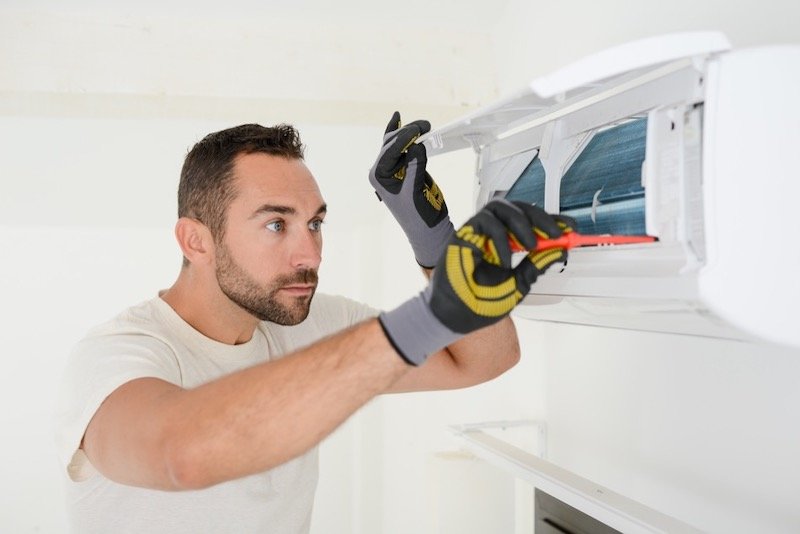
In addition to the standard cleaning procedures described above, there are other things you can do to maintain your air conditioner.
GET REGULAR TUNE UPS
Most air conditioner repair people and HVAC repair companies offer tune up service for customers. This preventative maintenance can prolong the service life of your air conditioner. Get a tune up once every year or two years starting from the time when your air conditioner is installed.
When hiring an HVAC repair contractor, shop around for good deals, but also consider the reputation of the contractor you decide to hire. Generally speaking, a reputable contractor will have references, testimonials on their website, transparent fee structures and more. Make sure your contractor has the appropriate licenses and certifications for your state.
KEEP THE CONDENSER FREE FROM OBSTRUCTIONS
Keep obstructions like shrubs, flowers and fences, about 2 feet away from your condenser, to ensure good air flow around the unit. If you must encase the condenser in a fence closer than 2 feet, install a chain-link fence.
WEATHERSTRIP YOUR HOUSE
Weatherstripping your house may not sound like it would affect your air conditioner’s performance, but it does. The more energy efficient your house is, the easier it is for your air conditioner to do its job.
- Seal the cracks between doors, windows and their frames with strips of expandable foam.
- Install a rubber seal at the threshold to your exterior doors to prevent cold air from entering your home.
- Seal your windows with plastic sheeting in the winter, if necessary.
- Use caulk to close all gaps in your home’s foundation and in the cracks around windows and doors.
There are different kinds of weatherstripping you can install. Walk around your house before going somewhere to buy weatherstripping, and identify areas where air leaks are affecting your home’s temperature. This will help you decide what kind of weatherstripping is right for your home when you’re making your purchase.
Measure doorways and windows to help you decide how much weatherstripping you’ll need. Pay close attention to unusually cold or hot rooms at certain times of the year, as these rooms are the most likely to need weatherstripping.
KNOW THE SIGNS OF AC TROUBLE
Knowing the signs of AC trouble can help you decide when it’s time to contact a professional:
- Air conditioner makes a loud noise
- Air blowing through the vents smells bad
- Some parts of the home remain hot and stuffy, others cool off
- The air conditioner blows warm air or won’t turn on at all
- Thermostat turns off prematurely
- Blower runs constantly
- The house remains humid even when the air conditioner runs
If you experience any of these problems, contact a professional.
TEST YOUR AIR CONDITIONER BEFORE EVERY COOLING SEASON
Before summer comes each year, test your air conditioner. Wait until a day when the temperature outside is 70 degrees or higher, then turn on your air conditioner. Once it starts running, go through the house and check all the vents. Cold air should be blowing through each vent. You should smell no foul odors. If your inspection turns up problems, hire an HVAC professional.
CLEAN AND SEAL DUCTS AS NEEDED
Dirty air ducts can decrease your indoor air quality, while holes in the air ducts can cause your air conditioner to run inefficiently. Cleaning and sealing your air ducts can help your HVAC system run more efficiently. Watch for problems like uneven heating and cooling, or allergy flare ups when your HVAC system is running. If you’re having either of these problems, contact a professional to have your ducts inspected.
COMMON AIR CONDITIONER PROBLEMS
Knowing the most common air conditioner problems and how they manifest can help you decide if something is wrong with your air conditioner. In some cases, knowing what’s wrong can help you fix the problem yourself. Other times, it’s important to hire a professional. Here’s what you need to know.
REFRIGERANT LEAKS
Refrigerant is the lifeblood of your air conditioner. If your air conditioner develops a refrigerant leak, it will eventually stop functioning. It cannot be fixed until the leak is stopped and the refrigerant is replaced. Sometimes, refrigerant leaks happen when an air conditioning unit is old and experiencing multiple leaks. Premature failure of the coils can be addressed, but if the coils are simply too deteriorated to be repaired, you may need to get a new air conditioner.
Signs of a refrigerant leak include:
- Unit runs all the time and never cools the home down to the proper temperature
- Air conditioner takes a longer-than-normal time to reach the right temperature
- Home is humid inside even when the air conditioner runs
- Air conditioner makes hissing noises when the unit isn’t running
- Ice forms on the evaporator coils
- Utility bills are higher than normal
As a homeowner, there’s nothing you can do about a refrigerant leak. Contact your air conditioner repair person to have the problem fixed.
INADEQUATE MAINTENANCE
Inadequate maintenance is another one of the most common problems. Problems from poor maintenance can manifest in different ways, depending on unit. If you rarely or never maintain your air conditioner system, just watch for gradual changes in your air conditioner’s performance and behavior.
Pay attention to how long the cooling cycles last, how much money you’re spending every year running your air conditioner, and how comfortable you are in your home. If you’re not up to the task of performing your own air conditioner maintenance, then it may be time to hire a professional to do the maintenance for you.https://www.youtube.com/embed/pBBnXHse-T0
ELECTRIC CONTROL FAILURE
Fans and other electronic parts can wear out, especially if your air conditioner is oversized for your property. If you get a tuneup once annually, your HVAC professional will catch these problems before they become an issue. However, if you never get a tuneup, you’re unlikely to catch these problems before they become a bigger issue. Watch for problems like:
- Fan makes an unpleasant noise when running.
- The fan doesn’t blow as well as it used to.
- The blower doesn’t produce as much cold air as it once did.
Sometimes, this can be the result of a motor problem; other times, it could be a loose part in the fan, or perhaps a worn wire. Either way, this problem should be addressed by a contractor.
SENSOR PROBLEMS
The sensor is a wire just behind the control panel, near the evaporative coil. The sensor measures the temperature of the air coming into the evaporative coil, and shuts off the compressor when the air temperature matches the air temperature setting on the thermostat. If the sensor is knocked out of place, the air conditioner may run erratically, either turning off early or late.
If the sensor is just in the wrong spot, you can fix this problem by adjusting it. It should be close to the coil, but not touching it. If there is nothing visibly wrong with the sensor, you may need to hire a professional to help you.
DRAINAGE PROBLEMS
The condensate drain line is an opening where condensation from the evaporator coils drip outside. Usually, the opening to the drain line is found outside near the condenser. You’ll be able to tell if the drain line is plugged if the condenser pan is full of water. If you’re not sure where the condenser pan is, check the owner’s manual for your HVAC system.
To clean the condensate drain, insert a wire brush into the drain line. When the line unplugs, a gush of water may run out of the line. If doing this does not unplug the line, then use duct tape to connect the hose from a wet/dry vacuum to the drain line. Turn on the vacuum and suck out the contents of the drain line for one minute. When you’re done, the drain pan should no longer have water in it. If it does, then it may be time to hire a professional.
HIRING A PROFESSIONAL
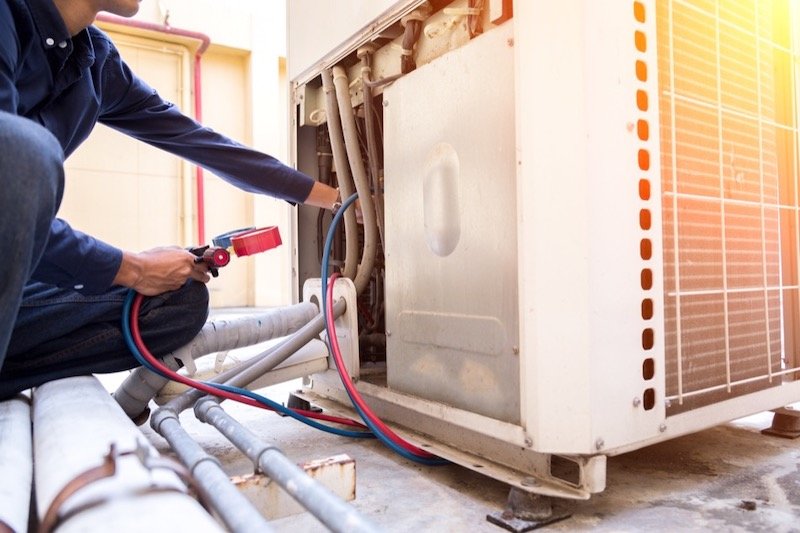
Some people question the value of hiring a professional contractor to make repairs to their air conditioner. Sometimes, the people who try to do their own repairs are unaware of how complicated these systems really are. There are many reasons to hire a professional contractor.
QUALITY OF REPAIR
Even if a homeowner is able to make the repair themselves, they may not be able to do it right or make the repair last. When a professional makes a repair, they should be able to do the work right the first time.
CONTRACTORS HAVE INSURANCE
When working with a major electrical appliance, there’s always a risk of injury or damage. An experienced and trained contractor should be at a low risk for these problems. However, if there is an incident, they should also have insurance to cover their injuries (if they have any) and damage to your property. If you are trying to make a repair to your own appliance, any damage you do will be a problem you’ll have to deal with personally.
CONTRACTORS HAVE THE RIGHT TOOLS
Often, big pieces of equipment like air conditioners require special tools to make repairs. Contractors have the right tools to do the job, but often homeowners do not. In making repairs, homeowners can sometimes do more damage than good because they’re using the wrong tools.
CONTRACTORS ARE FASTER
Because they’re specially trained and know what they’re doing, contractors can often do the work in half the time of a homeowner. Whereas your repairs to your air conditioner might put your air conditioner out of commission for hours or even days, an HVAC professional would likely be able to finish the job in a fraction of the time.
WHAT TO EXPECT
When you hire a contractor to come work on your air conditioner, you can expect your HVAC professional to show up at the designated time and perform some or all of the following steps:
- Use a leak detector to check for refrigerant leaks
- Test the air conditioner for the proper amount of refrigerant
- Measure air flowing to the evaporator coil
- Inspect the motor, recommend part replacement or oil replacement as needed
- Test the ducts and seal leaks
- Check the thermostat for accuracy
- Clean and tighten connections on electrical terminals
- Test the electric control sequence
Each contractor may offer their own deals at different rates. Shop around for the contractor with the best reputation who offers the most services at the most reasonable price.
TIME FOR AN UPGRADE?
Air conditioners have a lifespan. At the beginning, they are efficient, and should have few or no maintenance problems. Good quality air conditioners also have a warranty when they’re first installed. Over time, the warranty ends, the system starts to function less efficiently and maintenance problems start to occur. Eventually, all air conditioners must be replaced.
Knowing how long to expect your air conditioner to last can help you decide when it’s time to install a new air conditioner. Often, this time comes before the unit actually stops functioning. Making an upgrade before the air conditioner fully stops functioning can help you avoid some of the most costly repairs. Talk to your air conditioner repair person about your air conditioner’s age and expected service life. This will help you decide when it’s time to get a replacement.
Installing a quality product, working with a good HVAC contractor and staying on top of air conditioner maintenance can help you stay comfortable throughout the warmer days of the year.


